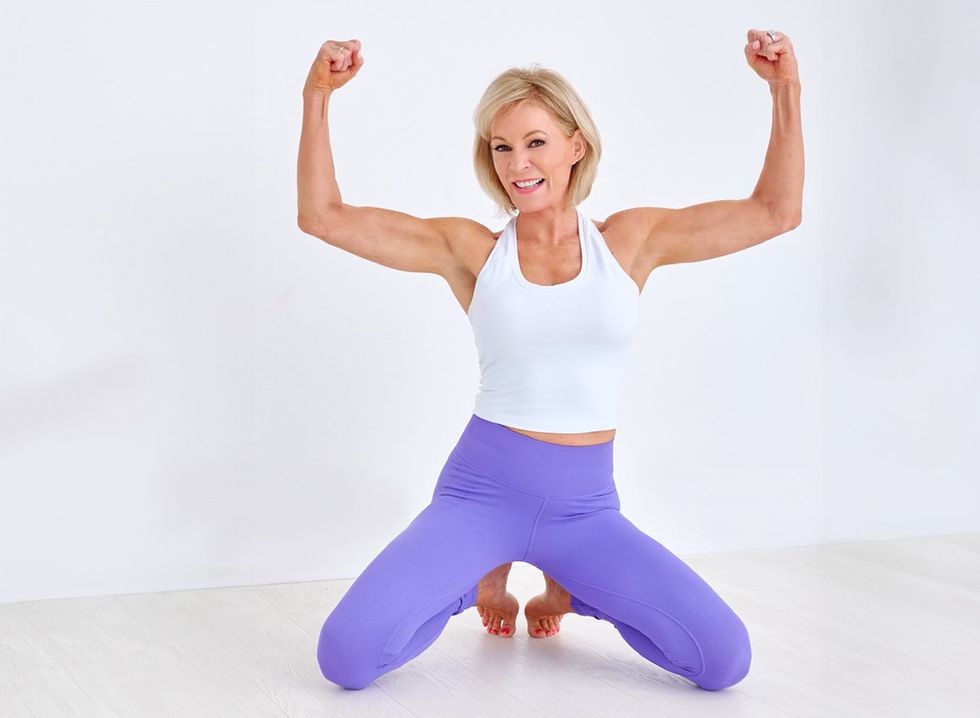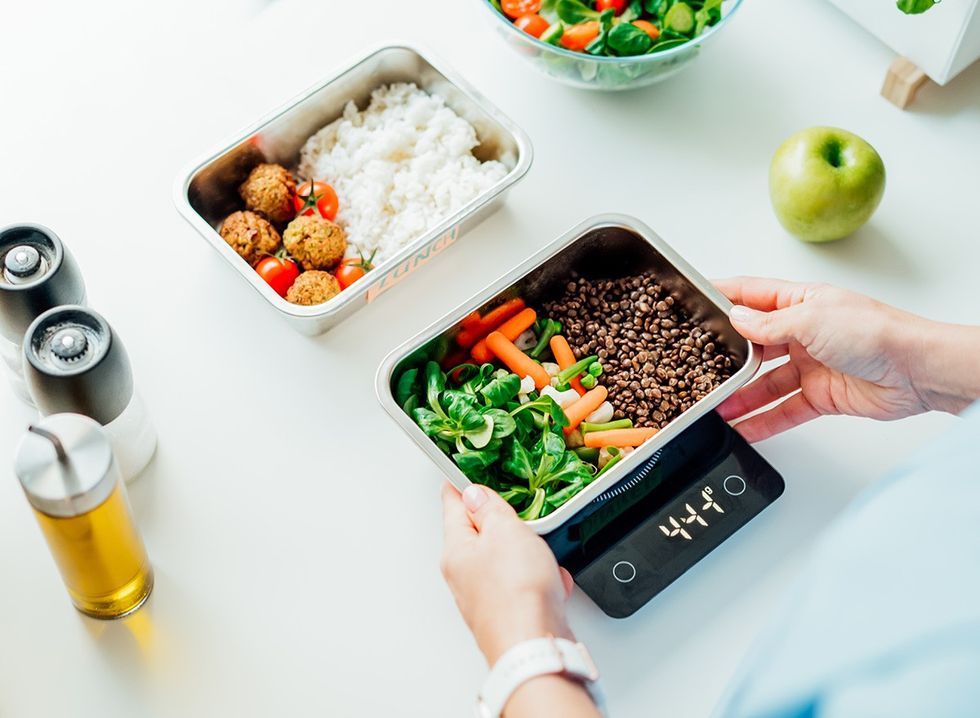Want barre movies that sculpt your body? You've come to the right place. For the last 20 years as a fitness instructor, I have taught more than 12,000 fitness classes all over the US and even as far away as Bangkok, Thailand, and my focus and specialty has been mind/body, and specifically, Pilates. For my own personal fitness practice, my go-to is Pilates, strength training; and Barre (or dance in general). Why? Barre/Dance appeals to my love of moving to the beat and it brings out my creative mind and frees up my body. With that in mind, here are 11 Barre moves that sculpt your body.
The Benefits of Strength Training

For me, strength training has always been appealing – and being in the group fitness industry for over 30 years, I love to move to music! And moving to music while lifting weights fulfills the immediate benefits of weight training. Here is a quick list of benefits of strength training:
- You'll build muscle strength (helps with ability to do your daily tasks)
- It burns calories more efficiently (building muscle increases metabolic rate)
- You decrease risk of falls (ability to support your own body)
- It lowers risk of injury (improves overall strength and range of motion around joints)
- It helps with bone strength/density (weight-bearing exercises place stress on bones, which helps to build bone density and reduces risk of osteoporosis)
- It improves brain health (studies show improvements in cognitive function)
- You'll have better self-esteem and quality of life (helps you to work towards a goal and appreciate your own body’s ability to overcome challenges)
And while I love a good weightlifting workout with light to moderate weights (especially if I have my favorite music playing) – there’s nothing better than incorporating Barre/Dance moves and building strength with my own body weight. It also means that I can do this type of workout anywhere – outside, at the wall at home, and with or without music.
Step 1: START!

While this may be the toughest step – once started and implemented into a consistent and daily routine – it becomes an easy and adaptable item to your list of daily tasks.
Step 2: Survey Your Equipment and Get Creative

What do you have in the way of props, equipment, and space? Survey the area (unless you are working out in a dedicated group exercise room or gym) and figure out what you’ve got. For instance, I do pushups at my kitchen counter while making coffee (I know a bit much right? Yet, totally true and I will use other props like a chair or table for the same thing if I’m in a hotel room). I will also use a wall or doorway for balance and or a windowsill to bring the floor to me. For props – you can use soup cans if you don’t have weights, or a filled or partially filled water bottle to add a bit of resistance.
I fortunately have weights, plates, and a barbell so am fully equipped to take on any number of strength training options into my workouts. Other useful props for Barre and strength training are resistance bands (I prefer light and long), Pilates circle/ring, yoga blocks (I like the cork ones that have a bit of density and weight to them), foam rollers, are small stability balls are some favorite options.
Step 3: Think on Your Feet

Your feet…while doing Barre doesn’t require shoes – you can wear them if you need support (a flexible cross trainer or dance shoe is best if you must wear shoes). I like to wear socks either with or without grip on the bottom if on a hard surface yet prefer being barefoot for carpet. For strength training with weights, it is recommended to wear shoes to protect your feet on hard surfaces and protect the foot if you drop a weight.
Step 4: One Step at a Time

Start slow and simple – for instance, set a goal of moving for 5 mins every other day. This might seem like nothing – yet it IS something, and if you make the goal 5 minutes of ‘movement’ you can walk around your space, or outside for 5 minutes and that is your workout every other day. Then you can start to define with more clarity your goals (i.e.: lose weight, gain more muscle, lift a certain weight, workout for 30 mins every other day, etc).
There’s nothing worse than laying out a plan that is too "lofty" – and while it might be well intentioned, if you fail to achieve your goal in the first week, you might be too defeated to re-think or restructure your plan. If you take a break, start again, and again, and again. Life will always ‘life’ for us – imposing challenges as well as inspirations. Doing something is always better than doing nothing! Some of My Favorite Barre Moves That Sculpt Your Body
Plie/Knee Bend

From any foot starting position, bend the knees forward over the center of the foot, keeping the heels grounded and torso upright. Only go as far as possible without lifting the heels from the ground.
Releve/Heel Lift

Lift the heels off the floor by rolling onto the ball of the feet, keeping the ankle, knee, and hip in line with the center of the foot as the heel lifts.
Tendus (means: stretched)

A brush of the toes along the floor, both legs stay straight throughout the movement. This can be done in any direction. The toes stay in contact with the floor.
Chair/Squat

Bend the knees and hinge the hips at the same time to sit back and down. This can be done in parallel or turned out with the feet narrow or wide.
Lunges (90/90, Tilt, Curtsy)

Beginning with the feet hip distance, take a long step back with either leg and place the ball of the foot down. Continue to bend both knees while keeping the torso upright and over the back knee. Straighten and step in to switch legs OR stay down and continue onto Forward Tilt Lunge by straightening and bending the back knee to bring the head and torso in line with the back heel. Bend to come upright and either continue with more repetitions or step in to step out with the other leg and switch sides. The curtsy the bending and straightening of the legs with 1-leg crossed bend the other. The back heel stays up and the front heel is grounded throughout all variations of the Lunges.
RELATED: This Plan Is How to Lose 5 Percent Body Fat In 2 Weeks
Chasse

Across floor – a move in which 1 foot ‘chases’ the other – typically done with straight legs & pointed toes.
Saute

A jump, bend the knees and push off the feet from heel to toes to straighten the legs and lift from the ground. To land, toes to heels bring each foot to the floor and bend the knees to fully absorb the landing with ease.
Port de bras

The technique and practice of arm movement in ballet. This simply means the carriage of the arms, or posture and movement of the arms. Moving from en bas (in front of hips), to first (out in front), to fifth (overhead), to second (out to the side); and then back to the hips. In other words – make a circular motion (front, overhead, side, start) and this can move in both directions. Excellent way to strengthen and sculpt the arms and shoulders while maintaining good, upright posture. For additional strengthening, do the movements with a light weight (1-3 lbs) in each hand (or a soup can or semi filled water bottle).
Attitude/Arabesque

Bring one leg to the front of the body (lifted knee bent and turned out) – Attitude; and then sweep down and lift to the back (bent knee with a turned-out hip). And now some Floorwork Moves
Bridges

Knees bent, feet flat on the floor (or on the wall or stationary barre); lift the hips by articulating from the tailbone to the upper back; or lift the hips straight up keeping the lower back in the starting position. Either lower back down the way you came up, or pulse moving the hips down and up in a small range of motion. Option to lift one leg then the other while maintaining the lifted hips, or lift one leg as you press the hips up.
Press up (pushups)

From an all fours (hands under shoulders, knees under hips, torso 1-long line from head to tail), semi plank (hands under shoulders, hips extended and on the floor), or full plank position (hands under shoulders and toes under heels with the legs straight, 1-long line from head to heels); bend the elbows to bring the chest to elbow height, then straighten.
RELATED: Alexia Clark Shows Off Her Sports Bra and Shares Surprising Body Weight Exercises Alternatives
The Biggest Mistakes to Avoid

The biggest mistake is not doing Barre at all! Here are a few others:
- Clenching the glutes – i.e., tucking the pelvis too far under – adjusts the upper body out of alignment, overworking the glutes and underutilizing the hamstrings and quads.
- Not maintaining neutral alignment and posture throughout the movements – usually happens when someone is using too much resistance and/or not paying attention to where their body is in space.
- Raising too high on the toes can cause pain in the feet and damage to the metatarsals and the foot itself. Think of lifting the heels only high enough to slide a 1” platform under the heel, and when coming down to the floor from a relieve, keep reaching the crown of the head to the ceiling.
Portia Page is a Balanced Body Educator, a Pilates teacher, and the author of "Pilates Illustrated."















 Shutterstock
Shutterstock Shutterstock
Shutterstock Shutterstock
Shutterstock Shutterstock
Shutterstock Shutterstock
Shutterstock Shutterstock
Shutterstock Shutterstock
Shutterstock Shutterstock
Shutterstock

 Shutterstock
Shutterstock Shutterstock
Shutterstock Shutterstock
Shutterstock Shutterstock
Shutterstock Shutterstock
Shutterstock Shutterstock
Shutterstock Shutterstock
Shutterstock Shutterstock
Shutterstock Shutterstock
Shutterstock Shutterstock
Shutterstock

 I’m 70 but Look 40 Thanks to These 7 At-Home ExercisesCopyright Liz Hilliard
I’m 70 but Look 40 Thanks to These 7 At-Home ExercisesCopyright Liz Hilliard Keep Moving Your BodyCopyright Liz Hilliard
Keep Moving Your BodyCopyright Liz Hilliard
 3. Side Plank - Sculpt Your WaistlineCopyright Liz Hilliard
3. Side Plank - Sculpt Your WaistlineCopyright Liz Hilliard
 2. Reach to Plank - Your Full-Body EnergizerCopyright Liz Hilliard
2. Reach to Plank - Your Full-Body EnergizerCopyright Liz Hilliard
 Deadlifts: The Ultimate Functional ExerciseCopyright Liz Hilliard
Deadlifts: The Ultimate Functional ExerciseCopyright Liz Hilliard
 Shutterstock
Shutterstock Shutterstock
Shutterstock Shutterstock
Shutterstock Shutterstock
Shutterstock

 I'm a Nutritionist and These 9 High-Protein Snacks Keep My Clients Full While Losing 50 Pounds
I'm a Nutritionist and These 9 High-Protein Snacks Keep My Clients Full While Losing 50 Pounds
 Shutterstock
Shutterstock 2. Processed FoodsShutterstock
2. Processed FoodsShutterstock Shutterstock
Shutterstock Shutterstock/Prostock-studio
Shutterstock/Prostock-studio Shutterstock
Shutterstock Pro TipsShutterstock
Pro TipsShutterstock Shutterstock
Shutterstock Shutterstock
Shutterstock Shutterstock
Shutterstock Shutterstock
Shutterstock Don’t Drink as Much AlcoholShutterstock
Don’t Drink as Much AlcoholShutterstock Most Women on GLP-1s Are Making a Few Common MistakesShutterstock
Most Women on GLP-1s Are Making a Few Common MistakesShutterstock Soda and Sugary DrinksShutterstock
Soda and Sugary DrinksShutterstock Shutterstock
Shutterstock Eat BreakfastShutterstock
Eat BreakfastShutterstock And Improve Insulin SensitivityShutterstock
And Improve Insulin SensitivityShutterstock Belly Flab Strip Tip: Sugar and Fat Calories Leave Its Mark on Your BodyShutterstock
Belly Flab Strip Tip: Sugar and Fat Calories Leave Its Mark on Your BodyShutterstock Shutterstock
Shutterstock The Drugs Mimic the GLP-1 Hormone Naturally Produced by the BodyShutterstock
The Drugs Mimic the GLP-1 Hormone Naturally Produced by the BodyShutterstock 3. Deep-Fried ItemsShutterstock
3. Deep-Fried ItemsShutterstock